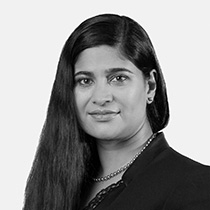Global markets started the year strongly, buoyed by the reopening of China, high levels of inflation starting to roll off and an expectation of a peak in policy rates. This optimism was subsequently somewhat dimmed as inflation remained stubbornly high, growth strong and unemployment low, with central bankers reiterating their commitment to continue with restrictive monetary policy until the job is done.
The extent of rapid rate hikes that developed markets have experienced over the past 12 months always ran the risk of resulting in something breaking. It turned out to be a run on a mid-size bank on the West Coast of the US that ultimately brought down Credit Suisse, a 166-year-old institution that (despite suffering a damaged reputation and low investor confidence) was in fact quite comfortable from both a capital and a liquidity point of view. The events in the global banking sector are expected to lead to tighter credit conditions, which has the positive spin-off of lower inflation resulting in less pressure on central banks to increase rates further. As a result, the quarter ended with markets rallying once again, reversing the declines of February. The MSCI All Country World Index returned 7.3% in USD for the quarter, although over 12 months is still negative at -7.4%. Similarly, the FTSE World Government Bond Index returned 3.5% for the quarter, but remains negative over 12 months at -9.6% total return.
South African markets followed the upward trend in global markets initially, but the impact of ongoing elevated levels of loadshedding on domestic economic growth is becoming increasingly apparent with cuts to GDP forecasts. In addition, softer commodity prices and an unbudgeted above-inflation increase in the public sector wage bill are once again focusing attention on sovereign debt sustainability. The FTSE/JSE Capped SWIX returned 2.4% for the quarter, the FTSE/JSE All Bond Index (ALBI) 3.4% and listed property (as measured by the FTSE/JSE Africa All Property Index) -4.8%. Over the past 12 months, total returns from the three asset classes are 0.2%, 5.8% and -5.1% respectively.
Against this backdrop, the Fund returned 5.1% for the quarter. Over the past 12 months, the Fund returned 7.4%, slightly ahead of elevated levels of inflation but behind the CPI+3% target. The Fund has delivered returns in excess of inflation over all meaningful periods, and ahead of target since inception.
Global assets provided the largest contribution to Fund returns over the past year, in stark contrast to the position just three months ago when they were the largest detractor. While global equity and bond markets remain negative in US dollar terms over 12 months, both asset classes have performed strongly in the first quarter, significantly reducing rolling negative returns. In particular, performance has benefited from exposure to the Coronation Global Opportunities Equity Fund and the Coronation Global Capital Plus Fund. At the same time, the rand has weakened by almost 18% since March 2022, resulting in strong positive returns in rand terms.
Domestic assets also contributed strongly to returns and good instrument selection in both equities and bonds resulted in outperformance of their respective indices. Within domestic equities, holdings in the global stocks of Naspers/Prosus, Richemont, Anheuser-Busch InBev, British American Tobacco and Glencore provided the largest contribution, while Anglo American, MTN, FirstRand, AngloGold Ashanti and Dis-Chem were the largest detractors.
In domestic fixed income, nominal bonds outperformed inflation linkers and cash over the 12 months. We continue to see the yields on SA government bonds as attractive but are mindful of the increased pressure that domestic structural challenges place on fiscal sustainability. As a result, we maintain duration of the bond carve-out at a level lower than the ALBI, while at the same time achieving an attractive real yield.
PORTFOLIO ACTIONS AND FUND POSITIONING
During the quarter, we reduced domestic equity exposure, particularly in some of the companies mentioned previously that have delivered strong outperformance. These are businesses that we continue to find attractive, and they remain significant positions in the domestic equity carve-out, but with a reduced margin of safety they warrant a smaller holding. Given a more fragile domestic fiscal outlook and higher cash yields, we also reduced exposure to domestic government bonds.
The proceeds of these sales were applied to building the domestic cash position as well as increasing exposure to offshore assets where we find more attractive risk-adjusted return opportunities, including the following:
- We continued to buy a basket of offshore oil and gas companies, replacing the poorer quality Sasol in the portfolio.
- While we continue to avoid longer-dated developed market government bonds, a spike in the yields on shorter-dated US Treasury Bills provided an opportunity to buy these instruments above 4.5%, which we consider attractive as a cash alternative.
- We continued to purchase attractively yielding corporate credit of businesses we know well, such as Quilter and Sasol.
- We have bought small positions in US and UK bank additional tier-1 (AT1) and tier-2 corporate paper.
The last action was motivated by the events surrounding the buy-out of Credit Suisse by UBS, in particular the inversion of the typical bank capital structure hierarchy. To engineer the transaction, the Swiss National Bank intervened to write the high risk AT1 capital to zero, thereby preserving (very little) value for equity holders. This had the knock-on effect of a repricing of bank contingent convertible paper across markets. Regulators in the US, Europe and UK were quick to confirm that AT1 capital would continue to rank senior to equity capital should a similar situation occur in their jurisdictions, but market participants remained sceptical. This provided the opportunity to buy the paper of some high-quality banks, where we consider the risk of a similar situation arising as extremely low, at attractive yields ranging between 9% and 11% in USD.
Global exposure sits at 31.6% effective at quarter end, compared to 29.1% in December 2022 and 24.1% 12 months ago (currency moves play a part here too). We are mindful of the impact that a volatile rand can have on the sequencing of returns for investors, so have hedged a portion of exposure back to rands using currency derivatives.
OUTLOOK
The global economy faces several countervailing forces. Inflation continues to roll over as base effects start to wash through and energy prices soften, yet levels remain stubbornly above central bank targets and labour markets remain tight. Strong economic growth indicators in the US and Europe had prompted concerns of higher interest rates for longer. However, the events of March may well lead to tighter credit conditions, resulting in a dampening effect on growth on the one hand but a quicker end to monetary policy tightening on the other. The Chinese economy has reopened and appears to be promoting a friendlier approach to capital markets, yet geopolitical tensions remain exceptionally high and there appears to be no end in sight to the war in Ukraine.
Domestically we continue to face our own set of challenges. Loadshedding has worsened and although significant investment by both corporates and individuals is going into self-generation, it will be some time before this starts to bear fruit. Transnet’s woes continue to strangle our ability to export the commodities that we produce. And while it’s not expected to have a significant impact on our ability to trade, grey listing is another cross in the box for those considering investment in the country. Despite some policy reforms that attempt to deal with these constraints, political leadership is absent and ongoing overtures to Russia threaten relationships with our established trading partners.
Valuations (of South African domestic assets in particular) appear compelling at face value but the environment in which we currently find ourselves has caused us to be more cautious in our outlook. Consequently, we have used the rally in the first quarter to dial down risk in the Fund slightly by reducing total equity exposure, raising liquid assets, and increasing the put protection we hold over both the global and domestic equity carve-outs. We believe the Fund is appropriately positioned to deliver on mandate beating capital growth from risk assets supplemented with a healthy yield from income assets.
Disclaimer
SA retail readers
 South Africa - Personal
South Africa - Personal



